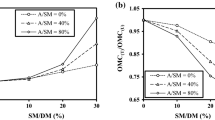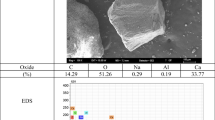Abstract
The use of industrial limes implies obtaining mortar pastes with worse plasticity and workability compared to lime putties. To overcome this inconvenience, a great number of additives can be used, the majority of them being plasticisers and water-retaining agents. In this work three natural polysaccharides with hydrogel properties (agar–agar, alginate and hyaluronate derivatives) were added to dry-hydrated and natural hydraulic limes to investigate their influence on the rheology of the lime suspensions, as a function of the mixing and dissolving procedures, the additive type and concentration, and the type of lime. Rheological measurements have shown that the yield stress and viscosity of the lime pastes are increased if the additives are pre-mixed with water before adding the lime powder. All additives significantly increase the rheological parameters of the natural hydraulic lime pastes (with a maximum additive concentration of 0.2 g in 1 L of water) but only sodium hyaluronate is effective when mixed with dry hydrated lime. Notwithstanding this, sodium hyaluronate-lime pastes have shown a time-dependent behaviour that must be taken into account during mortar formulation and use. This study lays the foundations for the development of new sustainable lime mortars made with additives derived from natural sources.



Similar content being viewed by others
References
Hendrickx R (2009) The adequate measurement of the workability of masonry mortar. Ph.D. Thesis, Katholieke Universiteit of Leuven, Belgium
Sickels LB (1981) Organic additives in mortars. Edinb Archit Res 8:7–20
Garate Rojas E (1993) Las Artes de la Cal. CBRIC-MEC, Madrid
Cowper AD (1927) Lime and lime mortars (Reprinted in 1998), Donhead edn. Building Research Establishment Ltd, Watford
Seabra MP, Paiva H, Labrincha JA, Ferreira VM (2009) Admixtures effect on fresh state properties of aerial lime based mortars. Constr Build Mater 23:1147–1153
Izaguirre A, Lanas J, Alvarez JI (2011) Characterization of aerial lime-based mortars modified by the addition of two different water-retaining agents. Cem Concr Compos 33:309–318
Ventolá L, Vendrell M, Giraldez P, Merino L (2011) Traditional organic additives improve lime mortars: new old materials for restoration and building natural stone fabrics. Constr Build Mater 25:3313–3318
Rodríguez-Navarro C, Ruiz-Agudo E, Burgos-Cara A, Elert K, Hansen EF (2017) Crystallization and colloidal stabilization of Ca(OH)2 in the presence of nopal juice (Opuntia ficus indica): implications in architectural heritage conservation. Langmuir 33(41):10936–10950
Rodríguez-Navarro C, Ruiz Agudo E, Ortega-Huertas M, Hansen E (2005) Nanostructure and irreversible colloidal behavior of Ca(OH)2: implications in cultural heritage conservation. Langmuir 21:24
Ruiz-Agudo E, Rodríguez-Navarro C (2010) Microstructure and rheology of lime putty. Langmuir 26(6):3868–3877
Vieira MC, Klemm D, Einfeldt L, Albrecht G (2005) Dispersing agents for cement based on modified polysaccharides. Cem Concr Res 35:883–890
Francavilla M, Pineda A, Lin CSK, Franchi M, Trotta P, Romero AA, Luque R (2013) Natural porous agar materials from macroalgae. Carbohydr Polym 92:1555–1560
Labropoulos KC, Niesz DE, Danforth SC, Kevrekidis PG (2002) Dynamic rheology of agar gels: theory and experiments. Part I. Development of a rheological model. Carbohydr Polym 50:393–406
Labropoulos KC, Niesz DE, Danforth SC, Kevrekidis PG (2002) Dynamic rheology of agar gels: theory and experiments. Part II: gelation behaviour of agar sols and fitting of a theoretical rheological model. Carbohydr Polym 50:393–406
Lahrech KH, Safouane A, Peyrellasse J (2005) Sol state formation and melting of agar gels rheological study. Phys A 358:205–211
Ross KA, Pyrak-Nolte LJ, Campanella OH (2006) The effect of mixing conditions on the material properties of an agar gel-microstructural and macrostructural considerations. Food Hydrocolloid 20:79–87
Park H, Lee KY (2011) Alginate/hyaluronate hydrogels for cartilage regeneration. J Control Release 152:e192–e269
Morais DS, Rodrigues MA, Silva TI, Lopes MA, Santos M, Santos JD, Botelho CM (2013) Development and characterization of novel alginate-based hydrogels as vehicles for bone substitutes. Carbohydr Polym 95:134–142
Kimica web page, consulted online on 21 Nov 2013. http://www.kimica-alginate.com/alginate/chemical_structure.html
FMC BioPolymer. The science of formulation. Alginates. www.fmcbiopolymer.com/portals/pharm/content/docs/alginates.pdf. Accessed 21 Nov 2013
Andersen T, Strand BL, Formo K, Alsberg E, Christensen BE (2012) Alginates as biomaterials in tissue engineering. J Carbohydr Chem 37:227–258
Oerther S, Le Gall H, Payan E, Lapicque F, Presle N, Hubert P, Dexheimer J, Netter P, Lapicque F (1999) Hyaluronate-alginate gel as a novel biomaterial: mechanical properties and formation mechanism. Biotechnol Bioeng 63(2):206–215
Storz H, Zimmermann U, Zimmermann H, Kulicke WM (2010) Viscoelastic properties of ultra-high viscosity alginates. Rheol Acta 49:155–167
Pelletier S, Hubert P, Payan E, Marchal P, Choplin L, Dellacherie E (2001) Amphiphilic derivatives of sodium alginate and hyaluronate for cartilage repair: rheological properties. J Biomed Mater Res 54:102–108
Inoue K, Song YX, Kamiunten O, Oku J, Terao T, Fujii K (2002) Effect of mixing method on rheological properties of alginate impression materials. J Oral Rehabil 29:615–619
US8246733B2 patent (2009) Inventor: Daniel R. DeBrouse. Original Assignee: Tamarisk Tech LLC
Charlot A, Auzely-Velty R (2007) Novel hyaluronic acid based supramolecular assemblies stabilized by multivalent specific interactions: rheological behavior in aqueous solution. Macromolecules 40:9555–9563
Murado MA, Montemayor MI, Cabo ML, Vázquez JA, González MP (2012) Optimization of extraction and purification process of hyaluronic acid from fish eyeball. Food Bioprod Process 90:491–498
Mo Y, Takaya T, Nishinari K, Kubota K, Okamoto A (1999) Effects of sodium chloride, guanidine hydrochloride, and sucrose on the viscoelastic properties of sodium hyaluronate solutions. Biopolymers 50:23–34
Park HO, Hong JS, Ahn KH, Lee SJ, Lee SJ (2005) Influence of preparation parameters on rheological behavior and microstructure of aqueous mixtures of hyaluronic acid/poly(vinyl alcohol). Korea-Aust Rheol J 17(2):79–85
Seuss S, Boccaccini AR (2013) Electrophoretic deposition of biological macromolecules, drugs and cells. Biomacromol 14:3355–3369
EN 459-1 (2010) Building lime. Part 1: definitions, specifications and conformity criteria. CEN, European Standard
Banfill P, Frias M (2007) Rheology and conduction calorimetry of cement modified with calcined paper sludge. Cem Concr Res 37:184–190
Gill SM, Banfill PFG (1987) The viscometric examination of cement pastes with interrupted helical impellers. Adv Cem Res 1:92–98
Tattersall GH, Banfill PFG (1983) The rheology of fresh concrete. Pitman, London
Davies OL (1957) The design and analysis of industrial experiments. Oliver and Boyd, London
Chatfield C (1983) Statistics for technology: a course in applied statistics, 3rd edn (revised). Chapman & Hall, Boca Raton. ISBN: 9780412253409
Yahia A, Khayat KH (2001) Analytical models for estimating yield stress or high performance pseudoplastic grout. Cem Concr Res 31:731–738
Choi JH, Kim SO, Linardy E, Dreaden EC, Zhdanov VP, Hammond PT, Cho NJ (2015) Adsorption of hyaluronic acid on solid supports: role of pH and surface chemistry in thin film self-assembly. J Colloid Interface Sci 448:197–207
Bolshakova AE, Melnikova NB, Nistratova LN, Pyanzina IP, Salikova TV, Gavrilova SA, Krasilnikova EV (2012) Suspension based on calcium carbonate and sodium hyaluronate for the prevention and treatment of bone diseases. Pharm Chem J 46(7):449–455
Acknowledgements
This study was financially supported by the European Commission under the Marie Curie program (FP7-PEOPLE-2012-IEF call, research project “NaturaLime”) and by the Spanish program “Juan de la Cierva incorporación” (JDC2015 call, Spanish Ministry of Economy and Competitiveness).
Author information
Authors and Affiliations
Corresponding author
Electronic supplementary material
Below is the link to the electronic supplementary material.
Rights and permissions
About this article
Cite this article
Arizzi, A., Banfill, P.F.G. Rheology of lime pastes with biopolymer-based additives. Mater Struct 52, 8 (2019). https://doi.org/10.1617/s11527-019-1310-8
Received:
Accepted:
Published:
DOI: https://doi.org/10.1617/s11527-019-1310-8




